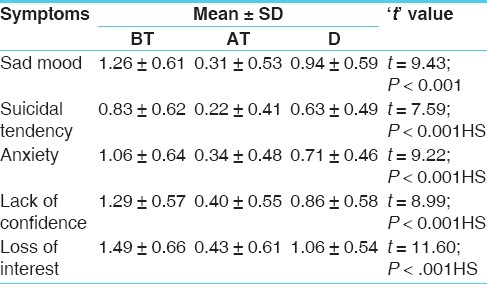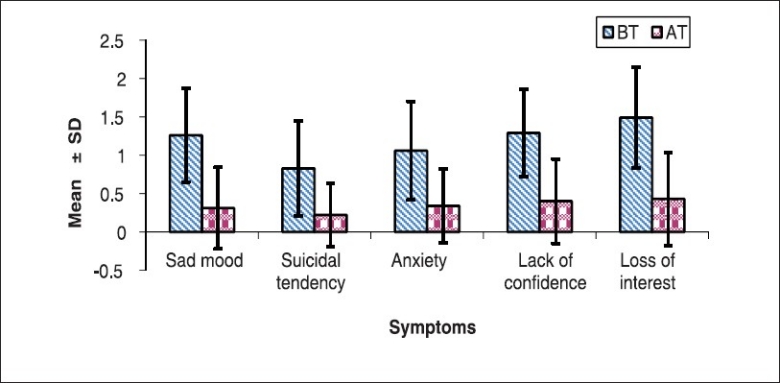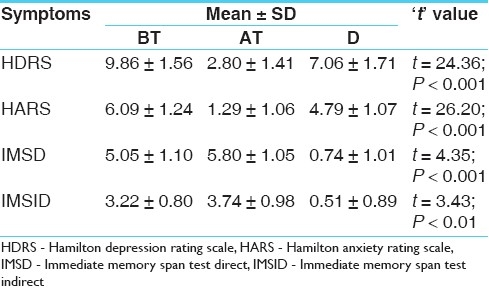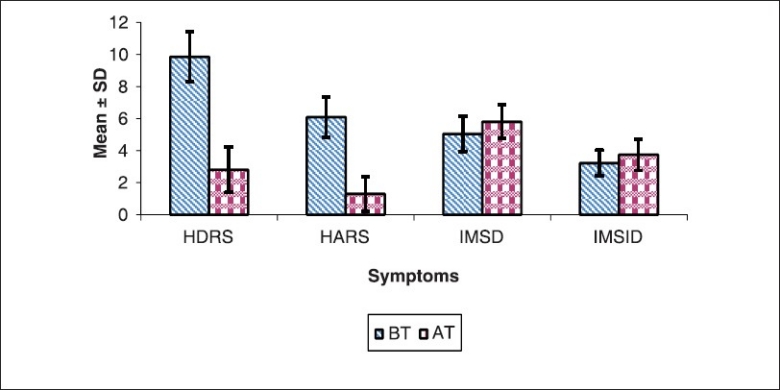Abstract
Depressive illness has been considered as a problematic mental illness since antiquity. The treatment modalities of depressive illness are of many kinds. Use of Medhya Rasayana drugs is a unique method of treatment described in Ayurveda for depressive illness. Kushmanda (Benincasa hispida) is one of the Medhya Rasayana as described by Bhava Mishra. Ghrita is also considered as Medhya Rasayana by almost all Acharyas. Keeping this background Kushmanda Ghrita has been selected as a trial drug to treat the patients of depressive illness. The study was carried out in 35 clinically diagnosed cases of depressive illness by using DSM-IV diagnostic criteria of depressive illness. All patients were given 20 ml of Kushmanda Ghrita in two divided doses morning and evening with 40 ml of lukewarm water for a period of one month. It has shown statistically significant results with psychometric parameters–Hamilton depression rating scale (t = 24.36, P < 0.001), Hamilton anxiety rating scale (t = 26.20, P < .001), immediate memory span direct (t = 4.35, P < 0.001), and indirect test (t = 3.43, P < 01) along with clinical symptoms.
Keywords: Depressive illness, Kushmanda, Medhya Rasayana
Introduction
Depression is a common psychiatric disorder characterized by depression of mood, over eating, excessive sleep, suicidal tendency, etc.[1] The basic patho-physiology of depressive illness is related to deficiency of Noradrenalin fiber activity or serotonergic fiber activity, deficiency of noradrenalin, or 5-HT serotonine.[2,3] When depression affects the person he/she has been dragged into a situation in which one lost his/her enthusiasm, working capacity, social and personal interactions, social and personal norms, etc.[4] This ultimately leads to mental and physical deficit of person. The person clinically presents with symptoms like sad mood, suicidal tendency, anxiety, unexplained fear, lack of confidence, lack of interest, etc. The depressive illness can cause loss of productivity, enjoyment, intimacy of individual and further that person becomes burden to not only to society but also to his own family and for himself.
Rasayana therapy is the unique therapeutic modality to rejuvenate the body and mind.[5] Further, Rasayana drugs acts by enhancing the digestion and metabolism, the nutritional quality of nutrient plasma (Rasa), micro-circulation of nutrient materials to the different basic body tissues.[6] Medhya Rasayanas specially improves the mental functions like memory, intellect, etc. along with quality of life.[7]
Kushmanda (Benincasa hispida) is mentioned as one of the medhya drug in the Ayurvedic literature.[8,9] Ghrita, the uttama sneha, considered best for stimulation of digestion, promotion of longevity, promotion of memory and intellect, and further described as yogavahi rasayana, means that any drug processed with ghrita will possess the quality of the added drug.[10]
Aims and objective
To evaluate effect of Kushmanda Ghrita on clinical symptoms in patients of depressive illness
To evaluate effect of Kushmanda Ghrita on psychometric parameters–Hamilton depression rating scale (HDRS),[11] Hamilton anxiety rating scale (HARS), immediate memory span direct, and indirect test in patients of depressive illness
Materials and Methods
For the present clinical study, a total of 40 patients were selected from OPD and IPD of Kayachikitsa, Sir Sunderlal Hospital, I.M.S., B.H.U., Varanasi. These patients were screened and diagnosed as depressive illness by using DSM-IV-diagnostic criteria of depressive illness as described below.
Diagnostic criteria
Inclusion criteria: the patients who fulfilled the DSM-IV diagnostic criteria for major and minor depressive disorder[12] were included in this study.
DSM-IV diagnostic criteria for minor and major depressive disorder
-
A.
For minor depressive disorder: at least two (but less than five) of the following symptoms. For major depressive disorder: five (or more) of the following symptoms. These symptoms have been present during the same 2-week period and represent a change from previous functioning; and at least one of the symptoms is either (i) depressed mood or (ii) loss of interest or pleasure.
Note - symptoms that are clearly due to a general medical condition, or mood-incongruent delusions or hallucinations are not to be included.
- Depressed mood most of the day, nearly every day, as indicated by either subjective report or observation made by others. Note–in children and adolescents can be irritable mood.
- Markedly diminished interest or pleasure in all or almost all activities most of the day, nearly every day.
- Significant weight loss when not dieting or weight gain (e.g. a change of more than 5% of body weight in a month), or decreased or increase in appetite nearly every day.
- Insomnia or hypersomnia nearly every day.
- Psychomotor agitation or retardation nearly every day.
- Fatigue or loss of energy nearly every day.
- Feelings of worthlessness or excessive or inappropriate guilt (which may be delusional) nearly every day (not merely self reproach or guilt about being sick).
- Diminished ability to think or concentrate, or indecisiveness, nearly every day.
- Recurrent thought of death (not just fear of dying), recurrent suicidal ideation without a specific plan for committing suicide.
-
B.
The symptoms do not meet criteria for a mixed episode.
-
C.
The symptoms cause clinically significant distress or impairment in social, occupational, or other important areas of functioning.
-
D.
The symptoms are not due to the direct physiological effects of a substance (e.g. a drug of abuse, a medication) or a general medical condition (e.g. hypothyroidism).
-
E.
The symptoms are not better accounted for by bereavement, i.e. after the loss of loved one the symptoms persist for longer than 2 months or are characterized by marked functional impairment, morbid preoccupation with worthlessness, suicidal ideation, psychotic symptoms, or psychomotor retardation.
-
F.
There has never been a manic episode, a mixed episode, or a hypomanic episode and criteria are not met for cyclothymic disorder.
-
G.
The mood disturbance does not occur exclusively during schizophrenia, schizophreniform disorder, schizoaffective disorder, delusional disorder or psychotic disorder not otherwise specified.
-
H.
For minor depressive disorder, there has never been a major depressive episode.
The exclusion criteria
Patients with following symptoms and having the history of following clinical conditions were excluded from this study.
Mood incongruent delusions or hallucinations incoherence or marked loosening of associations.
Patients superimposed with schizophrenia, schizophreniform disorders, mania, or bipolar disorders as psychotic disorder not otherwise specified.
Anxiety, obsessive compulsive disorders.
Chronic drug abuse, e.g. barbiturates, etc.
Toxic causes like alcohol ingestion and withdrawal.
Organic diseases like some diseases of gastrointestinal system (Irritable Bowel Syndrome, Colitis), Myocardial Infarction, CNS diseases (e.g. Alzheimer's diseases), metabolic and endocrine disorders, etc.
Preparation of drug
Kushmanda Ghrita preparation
The raw materials were purchased from the local market of Varanasi after proper identification.
Kusmanda ghrita was prepared at B.H.U. pharmacy, by using the standard pharmaceutical procedure of sneha kalpana vidhi.[13] The major ingredients are Kusmanda(Benincasa hispida) phala rasa, roots of Yastimadhu (Glycyrrhiza glabra) for kalka, Ghrita. Ghrita was added with 18 times of its quantity of juice of Kushmanda phala rasa and paste of Yastimadhu. The prepared Kushmanda Ghrita was packed in 600 ml containers each and dispensed to the patients as and when needed.
Dose and administration
All the patients were treated with Kushmanda ghrita 20 ml in two divided doses morning and evening with 40 ml of luke warm water for a period of 1 month.
The study design
Total 40 cases were registered for the study, after carefully examining their clinical presentation and fulfilling the inclusion criteria. Among these, 35 patients turned up for full follow ups and 5 patients drop out the study.
Evaluation/assessment criteria
The following clinical symptoms such as Sad mood, Suicidal tendency, Anxiety, Lack of confidence, Loss of interest and psychometric parameters such as Hamilton depression rating scale (HDRS), Hamilton anxiety rating scale (HARS), Immediate Memory Span Direct, and Immediate Memory Span Indirect test were used to evaluate the effect of trial drug.
Criteria for overall assessment of therapy
The effect of therapy was assessed considering the overall improvement in symptoms of the data was collected before starting the treatment and after the completion of follow-up. These scores compared with suitable statistical assessment and noted the P and t values.
Observations and Results
Out of 40 patients taken for the study 22 were male and 18 were female (male 55% and female 45%). It was found that the patients of age group 26-35 (35.00%) years exhibited greater prevalence of depressive illness [Table 1 and Figure 1].
Table 1.
Incidence of age and sex in 40 cases of depressive illness

Figure 1.

Incidence of age and sex in 40 cases of depressive illness
Discussion and Conclusion
In the present social setup man, who is social animal, lives under different kinds of stresses and pressures which leads to mood disturbances sometimes leads further into depressive disorders.[14] Depression is a symptom in some physical and psychological diseases and itself is a major psychological disease or disorder.[15] Measures to control the depression are being described in Charaka samhita[16] and the recordings are available from the time of Bhagvata Geeta to till date. Different varieties of herbal and herbo-mineral preparations are being tried for their efficacy in controlling the depression. These medicines to correct the depression used by different researchers are idle.
Therefore, this problem was selected for the clinical study and medhya drug Kusmanda Ghrita was chosen as a trial drug for the management of depressive illness. Kusmanda is described in Ayurveda as a medhya drug. Kusmanda has been used as the Kusmanda Ghrita, it is indicated in the treatment of mental disease. Besides this conceptual status, certain researche works done on Kusmanda have yielded beneficial effects on mental health. Hence, this lead was used for further studies on Kusmanda in the treatment of depressive illness. The results have been presented with necessary statistical analysis.
Kusmanda Ghrita has shown statistically highly significant results for symptoms such as sad mood, suicidal tendency, anxiety, lack of confidence, loss of interest [Table 2 and Figure 2]. It suggests that the most of the patients were found to have significant reduction in the degree of symptoms. This may be due to the medhya effect of the Kusmanda Ghrita.
Table 2.
Effect of trial treatment on clinical symptoms in patients of depressive illness (n = 35)

Figure 2.

Effect of trial treatment on clinical symptoms in patients of depressive illness (n=35)
The effect of trial drug observed on HDRS, HARS was statistically highly significant [Table 3 and Figure 3]. The immediate memory span test results suggest that the most of the patients were found to be increased immediate memory after treatment. These findings may be because of the medhya property of Kusmanda Ghrita.
Table 3.
Effect of trial treatment on psychometric tools (n = 35)

Figure 3.

Effect of trial treatment on Psychometric tools (n=35)
Thus, Kusmanda Ghrita has improved the depressive illness patients because of its medhya prabhava as described in Ayurveda. So it can be concluded that the Kusmanda Ghrita may possess antidepressant activity.
References
- 1.Ahuja N. A short text book of psychiatry. 5th ed. New Delhi: Jaypee Brothers Medical Publication Pvt Ltd; 2002. [Google Scholar]
- 2.Baranawal S, Singh RH. A clinical study on the Ayurvedic Management of Depressive Illness. M.D. Ay. Thesis Department of Kayachikitsa. Varanasi: I.M.S., B.H.U; 2000. [Google Scholar]
- 3.Dey S, Singh RH. Probable Involvement of Central Serotonin in Neurotransmission in the Antidepressant Effect of Physical exercise: Ph.D. Thesis, Department of Kayachikitsa. Varanasi: I.M.S., B.H.U; 1993. [Google Scholar]
- 4.Bhatiya MS. A Short text book of Psychiatry. 4th ed. New Delhi: Publishers and Distributors; 2002. [Google Scholar]
- 5.Singh RH. The Holistic Principles of Ayurvedic Medicine. Varanasi: Chaukhamba Publication; 1998. [Google Scholar]
- 6.Sing RH. AyurvediyaManasVijnana. Varanasi: Chaukhamba Publication; 1986. [Google Scholar]
- 7.Singh RH. Medhya Rasayana. Bulletin of Indian Medicine. Varanasi: Banaras Hindu University; 1976. [Google Scholar]
- 8.Mishra B. In: Bhava Prakash. Mishra BS, editor. Vol. 2. Varanasi: Chaukhamba Publication; 16th th Cent AD. [Google Scholar]
- 9.Sharma PV. Dravyaguna Vijnanam. Varanasi: Chaukhamba Publication; 1986. [Google Scholar]
- 10.Singh RH. Panchakarma therapy. Varanasi: Chaukhabha Publication; 1992. [Google Scholar]
- 11.Hamilton M. A rating scale for Depression Journal of Neurology, Neurosurgery and Psychiatry. 1960;23:56–62. doi: 10.1136/jnnp.23.1.56. [DOI] [PMC free article] [PubMed] [Google Scholar]
- 12.3rd ed Rev. Washington: 1987. American Psychiatric Association: Diagnostic and Statistical Manual of Mental Disorers. [Google Scholar]
- 13.Shastri AD. Bhaisajya Ratnawali. Varanasi: Chaukhamba Publications; 1996. [Google Scholar]
- 14.Gupta S, Singh RH. A clinical study of depressive illness and its Ayurvedic Management, M.D. (Ay.) Thesis: Department of Kayachikitsa. Varanasi: I.M.S., B.H.U; 2001. [Google Scholar]
- 15.Chandre R, Singh RH, Narasimha Murthy KH. Therapeutic evaluation of Nasya Karma and Ayurvedic Drugs/Medicated Ghrta in Cases of Depressive Illness M.D., Ay. Thesis: Department of Kayachikitsa. Varanasi: I.M.S., B.H.U; 2004. [Google Scholar]
- 16.Das B, Sharma RK. Agnivesa: CarakaSamhita English Translation. Vol. 3. Varanasi: Chaukhamba Publication; [Google Scholar]


